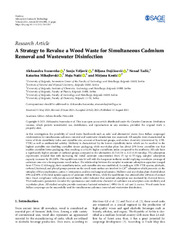Приказ основних података о документу
A Strategy to Revalue a Wood Waste for Simultaneous Cadmium Removal and Wastewater Disinfection
| dc.creator | Ivanovska, Aleksandra | |
| dc.creator | Veljovic, Sonja | |
| dc.creator | Dojčinović, Biljana | |
| dc.creator | Tadic, Nenad | |
| dc.creator | Mihajlovski, Katarina | |
| dc.creator | Natic, Maja | |
| dc.creator | Kostić, Mirjana | |
| dc.date.accessioned | 2022-03-04T11:21:34Z | |
| dc.date.available | 2022-03-04T11:21:34Z | |
| dc.date.issued | 2021 | |
| dc.identifier.issn | 0263-6174 | |
| dc.identifier.uri | http://TechnoRep.tmf.bg.ac.rs/handle/123456789/4877 | |
| dc.description.abstract | In this investigation, the possibility of wood waste (hardwoods such as oaks' and alternatives' staves from Balkan cooperage) revalorization for simultaneous cadmium removal and wastewater disinfection was examined. All samples were characterized in terms of their crystallinity index and crystallite size, amount of functional groups, and surface chemistry (determined by ATR-FTIR) as well as antibacterial activity. Mulberry is characterized by the lowest crystallinity index which can be ascribed to the highest crystallite size disabling crystallite denser packaging, while myrobalan plum has about 23% lower crystallite size that enables crystallite better packaging, thus resulting in a 42.4% higher crystallinity index compared to the mulberry. All oaks have a significantly higher amount of carboxyl groups compared to the alternatives (0.23-0.28 vs. 0.12-0.19 mmol/g). The adsorption experiments revealed that with increasing the initial cadmium concentration from 15 up to 55 mg/g, samples' adsorption capacity increases by 89-220%. The equilibrium data fit well with the Langmuir isotherm model implying monolayer coverage of cadmium ions over a homogeneous wood surface. The relationship between the samples' maximum adsorption capacities (ranged from 5.726 to 12.618 mg/g), their crystallinity index, and crystallite size was established. According to ATR-FTIR spectra, aldehyde, carboxyl, hydroxyl, and phenyl groups present on the wood waste surface are involved in Cd2+ adsorption which proceeds via the interplay of the complexation, cation-pi interactions, and ion-exchange mechanisms. Mulberry and myrobalan plum showed about 89% and 80% of the total uptake capacity of cadmium within 60 min, while the equilibrium was attained after 240 min of contact time. Good compliance with pseudo-second kinetic order indicated that cadmium adsorption was mediated by chemical forces. Thermodynamic parameters revealed the spontaneous and exothermic character of cadmium ion adsorption onto mulberry and myrobalan plum. All studied samples provide maximum bacterial reduction (>99%) for E. coli and S. aureus. Wood waste from Balkan cooperage can be successfully used for simultaneous cadmium removal and wastewater disinfection. | en |
| dc.relation | info:eu-repo/grantAgreement/MESTD/inst-2020/200026/RS// | |
| dc.relation | info:eu-repo/grantAgreement/MESTD/inst-2020/200051/RS// | |
| dc.relation | info:eu-repo/grantAgreement/MESTD/inst-2020/200135/RS// | |
| dc.relation | info:eu-repo/grantAgreement/MESTD/inst-2020/200168/RS// | |
| dc.relation | info:eu-repo/grantAgreement/MESTD/inst-2020/200287/RS// | |
| dc.rights | openAccess | |
| dc.rights.uri | https://creativecommons.org/licenses/by/4.0/ | |
| dc.source | Adsorption Science & Technology | |
| dc.title | A Strategy to Revalue a Wood Waste for Simultaneous Cadmium Removal and Wastewater Disinfection | en |
| dc.type | article | |
| dc.rights.license | BY | |
| dc.citation.other | 2021(): - | |
| dc.citation.rank | M21 | |
| dc.citation.volume | 2021 | |
| dc.identifier.doi | 10.1155/2021/3552300 | |
| dc.identifier.fulltext | http://TechnoRep.tmf.bg.ac.rs/bitstream/id/7328/4873.pdf | |
| dc.identifier.scopus | 2-s2.0-85113811529 | |
| dc.identifier.wos | 000687411900001 | |
| dc.type.version | publishedVersion |

